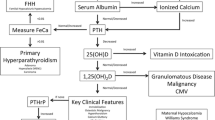Abstract
Idiopathic infantile hypercalcaemia (IIH) is a rare disorder of unknown etiology that presents with hypercalcaemia in a child’s first year of life. There is only a limited number of published reports of the natural history of this condition, and the long-term prognosis is largely unknown. The presentation, treatment and long-term follow-up of 11 children with IIH treated at our institution since 1993 are described. Hypercalcaemia resolved in the majority of children by the time they were 3 years of age, but nephrocalcinosis and persistent hypercalciuria were common, and, in some cases, urinary calcium excretion increased after initially becoming normal. This study suggests that clinical and biochemical abnormalities may persist for longer than previously reported and implies the need for ongoing surveillance of patients with IIH.


Similar content being viewed by others
References
Martin ND, Snodgrass GJ, Cohen RD (1984) Idiopathic infantile hypercalcaemia—a continuing enigma. Arch Dis Child 59:605–613
Rodd C, Goodyer P (1999) Hypercalcemia of the newborn: etiology, evaluation, and management. Pediatr Nephrol 13:542–547
Langman CB (1994) Disorders of phosphorous, calcium and vitamin D. In Holiday MA (ed) Pediatric nephrology. Williams & Wilkins, Sydney
McTaggart SJ, Craig J, MacMillan J, Burke JR (1999) Familial occurrence of idiopathic infantile hypercalcemia. Pediatr Nephrol 13:668–671
Schwartz GJ, Haycock GB, Edelmann CM, Spitzer A (1976) A simple estimate of glomerular filtration rate in children derived from body length and plasma creatinine. Pediatrics 58:259–263
Fanconi G, Girardet P, Schlesinger B, Butler H, Black JS (1952) Chronische Hypercalcemia kombinert mit Osteosklerose, Hyperazotomie, minderwuchs und kongenitalen miβbildungen. Helv Paediatr Acta 7:314–334
Lightwood R (1952) Idiopathic hypercalcaemia with failure to thrive. Arch Dis Child 27:302–330
Morris CA, Mervis CB (2000) Williams syndrome and related disorders. Annu Rev Genomics Hum Genet 1:461–484
Pronicka E, Rowinska E, Kulczycka H, Lukaszkiewicz J, Lorenc R, Janas R (1997) Persistent hypercalciuria and elevated 25-hydroxyvitamin D3 in children with infantile hypercalcaemia. Pediatr Nephrol 11:2–6
Karlowicz MG, Adelman RD (1995) Renal calcification in the first year of life. Pediatr Clin North Am 42:1397–1413
Langman CB, Budary AA, Sailer DE, Strewler GJ (1992) Non-malignant expression of parathyroid hormone-related protein is responsible for idiopathic infantile hypercalcemia. J Bone Miner Res 7:593
Cummings FJ (1994) Hypercalcemia of malignancy: pathophysiology and current treatment. Resid Staff Physician 40:55–60
Walsh CA, Birch MA, Fraser WD, Lawton R, Dorgan J, Walsh S, Sansom D, Beresford JN, Gallagher JA (1995) Expression and secretion of parathyroid hormone-related protein by human bone-derived cells in vitro: effects of glucocorticoids. J Bone Miner Res 10:17–25
Alon U, Berkowitz D, Berant M (1992) Idiopathic infantile hypercalcemia: rapid response to treatment with calcitonin. Child Nephrol Urol 12:47–50
Mizusawa Y, Burke JR (1996) Prednisolone and cellulose phosphate treatment in idiopathic infantile hypercalcaemia with nephrocalcinosis. J Paediatr Child Health 32:350–352
Burke JR, Cowley DM, Mottram BM, Buckner P (1986) Cellulose phosphate and chlorothiazide in childhood idiopathic hypercalciuria. Aust N Z J Med 16:43–47
Pak CY (1979) Clinical pharmacology of sodium cellulose phosphate. J Clin Pharmacol 19:451–457
Bushinsky DA, Monk RD (1998) Calcium. Lancet 352:306–311
Shoemaker L (1999) Expanding role of bisphosphonate therapy in children. J Pediatr 134:264–267
Lteif AN, Zimmerman D (1998) Bisphosphonates for treatment of childhood hypercalcemia. Pediatrics 102:990–993
Schell-Feith EA, Kist-van Holthe JE, van Zwieten PHT, Zonderland HM, Holscher HC, Swinkels DW, Brand R, Berger HM, van der Heijden BJ (2003) Preterm neonates with nephrocalcinosis: natural course and renal function. Pediatr Nephrol 18:1102–1108
Author information
Authors and Affiliations
Corresponding author
Rights and permissions
About this article
Cite this article
Huang, J., Coman, D., McTaggart, S.J. et al. Long-term follow-up of patients with idiopathic infantile hypercalcaemia. Pediatr Nephrol 21, 1676–1680 (2006). https://doi.org/10.1007/s00467-006-0217-0
Received:
Revised:
Accepted:
Published:
Issue Date:
DOI: https://doi.org/10.1007/s00467-006-0217-0




